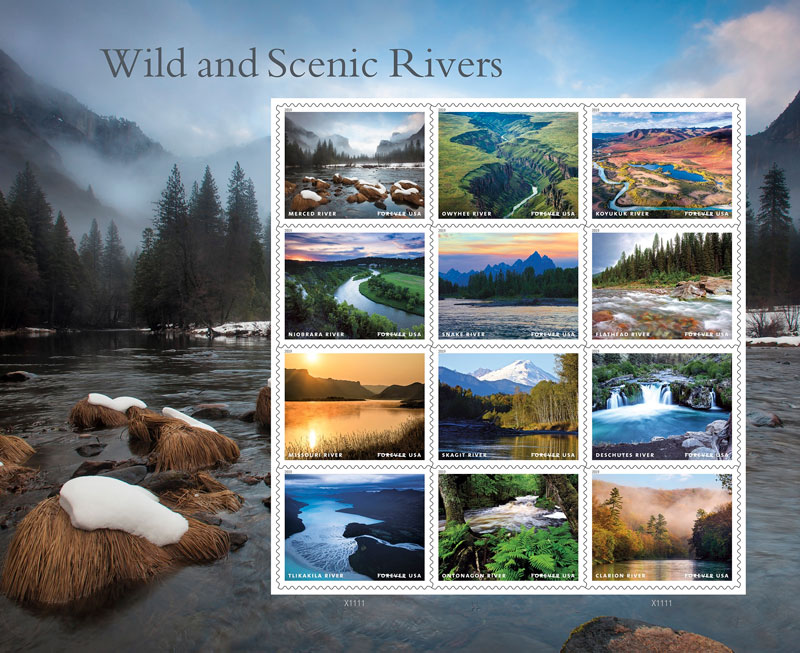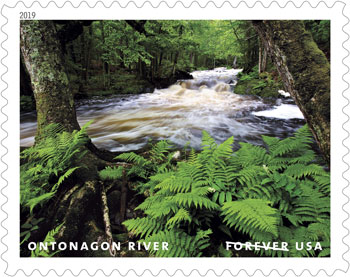The Flathead, Deschutes, Ontonagon, and Koyukuk are among more than 200 waterways protected by the U.S. National Wild and Scenic Rivers System. They are also among the 12 free-flowing rivers splashing, burbling, and cascading in an evocative set of Forever stamps that the U.S. Postal Service (USPS) is issuing starting today, 21 May.
Nearly 51 years after U.S. President Lyndon Johnson signed into law the Wild and Scenic Rivers Act in August 1968, USPS is printing up 5 million panes of the 12-stamp collection for a total of 60 million stamps
“Holy mackerel!” Tim Palmer, one of the photographers featured in the stamp set, told Eos upon hearing about the number of stamps being printed.
That’s more than 2,660 first-class letters that can be posted for every kilometer of the Wild and Scenic Rivers System, which currently protects more than 22,530 kilometers of riverways. That includes 418 kilometers added in March to the system that designates and protects rivers and river stretches as wild, scenic, or recreational.
Stamps That Represent the Best of America
The postal service views its job in printing stamps “as representing the best of America.”
Scenic stamps do very well with the general public, said William Gicker, acting director of USPS Stamp Services. The postal service views its job in printing stamps “as representing the best of America. And we want to do things that are, of course, also popular with the American buying public,” he told Eos. These river stamps fit both criteria, he said.
Each year, the Citizens’ Stamp Advisory Committee, appointed by the postmaster general, receives about 40,000 requests for new stamp designs, and USPS issues about 25, Gicker noted.
This new set of stamps, designed by USPS art director Derry Noyes, includes spectacular photographs of rivers from across the United States by three of the country’s best nature photographers: Michael Melford, who has been featured in National Geographic magazine and elsewhere; Bureau of Land Management staff photographer Bob Wick; and naturalist and author Palmer, who has written extensively about the Wild and Scenic Rivers System.

A Special Stamp of Montana’s Flathead River
Among Palmer’s four photos featured in the stamp set is a picture of Montana’s Flathead River near Glacier National Park. That exact location, a narrow stretch along the river, is the site where the U.S. Army Corps of Engineers in the 1950s had proposed building the Spruce Park Dam. During a successful fight to block that dam, pioneering wildlife biologists John and Frank Craighead made a case for protecting the nation’s remaining wild rivers, according to Palmer. “That was the seed that grew into the National Wild and Scenic Rivers Act,” he said.
“I actually would have run in to get an even earlier morning photo except that’s prime grizzly bear country and I did not want to surprise a bear by approaching quickly on a dark trail.”
The photo shoot was pretty special, too, according to Palmer, author of a number of books, including Wild and Scenic Rivers: An American Legacy and America’s Great River Journeys: 50 Canoe, Kayak, and Raft Adventures.
“It was just a beautiful summer morning. You’re high in the mountains, so there is that cool brisk air of the northern Rockies, and it’s pine and fir scented because it’s all coniferous forest there. And this magnificent crystal clear water was just bubbling through and rushing by,” he recalled. “The rocks are this gorgeous mosaic of metamorphic color: red, gray, blue, black, white.”
Palmer said that he got up before dawn to hike the 12 kilometers to the site. “I actually would have run in to get an even earlier morning photo except that’s prime grizzly bear country and I did not want to surprise a bear by approaching quickly on a dark trail,” he added.
Photography “Makes You See”
Palmer’s other photos in the stamp set include a sunrise shot of Washington’s Skagit River, a “classic scene” of Wyoming’s Snake River, and a shot of Michigan’s Ontonagon River rushing through a lush gorge.
“The really wonderful thing about photography is that it makes you see,” he told Eos. “We can all be looking at things but not really seeing them. When you’re there to take a photo, you’re looking deeper: for light and for movement and for contrast and for color.”

There is something “extremely refreshing” about entering this other world “of just astonishing beauty,” he said, summing up his experience of photographing rivers.
“All of this begins to build emotionally. I’m there physically, it’s fun, it’s a beautiful scene, I’m enjoying that. The river is making these wonderful sounds. And I’ve got a creative mission to accomplish here, which is to capture the photos,” he said. “I realize that all of this is for sharing it with other people and the rest of the world so that they, too, can know the value of wild rivers and therefore protect them.”
Gicker at USPS added that one of the biggest challenges of designing stamps is creating “an impactful image in a very small size that captures your attention and imagination very quickly.”
Gicker told Eos that he hopes people will see these river stamps as “a little light in their day” and “stop to think about what this country is. It’s not just the highways that [we] see driving to work.’”
—Randy Showstack (@RandyShowstack), Staff Writer
Citation:
Showstack, R. (2019), New stamps tell a wild and scenic river story, Eos, 100, https://doi.org/10.1029/2019EO124429. Published on 21 May 2019.
Text © 2019. AGU. CC BY-NC-ND 3.0
Except where otherwise noted, images are subject to copyright. Any reuse without express permission from the copyright owner is prohibited.
Text © 2019. AGU. CC BY-NC-ND 3.0
Except where otherwise noted, images are subject to copyright. Any reuse without express permission from the copyright owner is prohibited.

